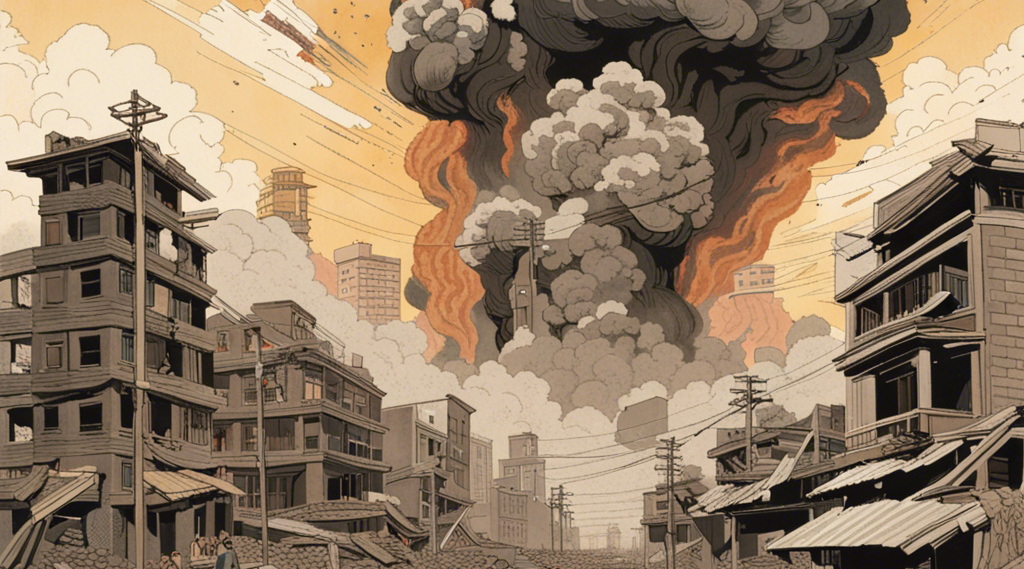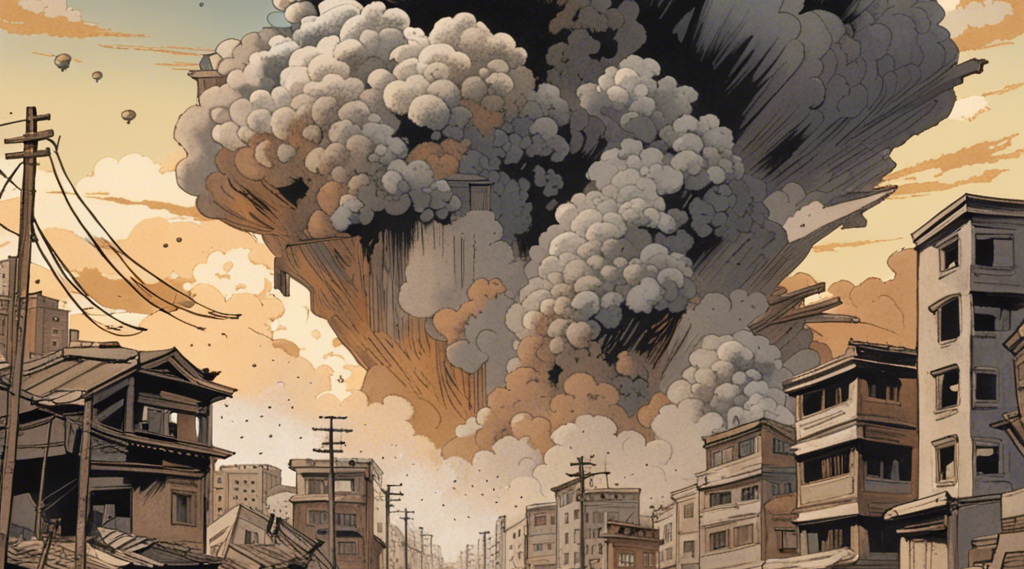
Chapter 1 What’s the Book Hiroshima about
"Hiroshima" is a non-fiction book written by John Hersey. It was originally published as an article in The New Yorker in August 1946 and later expanded into a book.
The book recounts the experiences of six individuals who survived the atomic bombing of Hiroshima on August 6, 1945, during World War II. Hersey interviewed these survivors extensively and documented their personal stories, capturing the immediate aftermath of the bombing and the long-term effects it had on their lives.
The book provides a detailed and harrowing account of the events leading up to the bombing, the horrors experienced by those caught in the blast, and the struggles they faced in the aftermath. Through the stories of these individuals, Hersey explores the physical, emotional, and psychological impact of the atomic bomb on both individuals and society as a whole.
"Hiroshima" is widely regarded as a groundbreaking work of journalism, offering a humanistic perspective on the devastating consequences of nuclear warfare. It remains a significant historical document that sheds light on the tragedy of Hiroshima and serves as a reminder of the importance of peace and the prevention of nuclear weapons.
Chapter 2 Is Hiroshima A Good Book
"Hiroshima" by John Hersey is widely regarded as an important and powerful book. It chronicles the stories of six survivors of the atomic bombing of Hiroshima in 1945, providing a firsthand account of the devastating impact of nuclear warfare on individuals and society. The book is well-researched and has been highly influential in shaping public perception of the event. If you're interested in learning about the human consequences of the atomic bomb and its aftermath, "Hiroshima" is often recommended as an informative and impactful read.
Chapter 3 Summary of Hiroshima
In this article, we delve into John Hersey's groundbreaking work, "Hiroshima," which offers a gripping account of the aftermath of the atomic bombing on the city during World War II. Through extensive research and interviews with survivors, Hersey provides a vivid portrayal of the horrors experienced by the people of Hiroshima, while also highlighting their resilience and courage in the face of unimaginable devastation. Join us as we explore the profound impact of "Hiroshima" and the lasting significance of its storytelling.
Chapter 4 Author for Hiroshima
The book "Hiroshima" was authored by John Hersey, an American journalist and writer. He released the book in 1946, just one year after the devastating atomic bombing of Hiroshima, Japan, during World War II.
John Hersey has written several other books throughout his career. Some notable works include:
- "The Wall" (1950) - This novel tells the story of a Warsaw Ghetto uprising during the Nazi occupation of Poland in World War II.
- "The Child Buyer" (1960) - It is a satirical novel that explores the concept of child labor and the ethical implications involved.
- "White Lotus" (1965) - The book centers around an American doctor working in a hospital in Vietnam during the Vietnam War and delves into themes of war and cultural clash.
- "A Bell for Adano" (1944) - This novel won the Pulitzer Prize in 1945 and portrays life in an Italian town controlled by the US military during World War II.
Among these works, "Hiroshima" stands out as John Hersey's most influential and widely read book. It remains a seminal work of nonfiction and has been recognized for its groundbreaking narrative style and its profound impact on raising awareness about the human suffering caused by the atomic bomb.
In terms of editions, it is subjective to determine which edition is the best. However, the original edition published in 1946 is highly regarded due to its historical significance and the immediacy of the events covered. Subsequent editions may contain additional materials or revisions, but the original edition often holds a special place in the hearts of readers.

Chapter 5 Hiroshima Meaning & Theme
1. Meaning of Hiroshima
"Hiroshima" is a non-fiction book written by John Hersey. It was published in 1946 and serves as a detailed account of the experiences of six survivors of the atomic bombing of Hiroshima, Japan, on August 6, 1945.
The book primarily focuses on the human stories of these survivors, providing a vivid and personal portrayal of the catastrophic event and its aftermath. Hersey's intention in writing "Hiroshima" was to bring attention to the devastating effects of nuclear weapons and to promote peace by highlighting the individual suffering caused by such destruction.
Through his narrative, Hersey explores the physical and emotional trauma experienced by the survivors, their struggles for survival, and the impact of the bombing on their lives. He also delves into the societal and political context surrounding the attack, reflecting on the decision to use atomic weapons and raising ethical questions about warfare and the responsibility of humanity.
Overall, "Hiroshima" aims to convey the horror and long-lasting consequences of the atomic bombing, while encouraging readers to reflect upon the moral implications of such destructive power. The book is widely regarded as a powerful testament to the human cost of war and has played a significant role in shaping public perception of nuclear warfare.
2. Theme of Hiroshima
The theme of "Hiroshima" by John Hersey revolves around the catastrophic event of the atomic bombing of Hiroshima during World War II and its profound impact on human lives. The book explores several key themes:
- Human resilience and survival: Despite the unimaginable devastation caused by the atomic bomb, the survivors demonstrate remarkable strength and resilience in their efforts to rebuild their lives. Through their stories, Hersey highlights the indomitable spirit of humanity.
- Consequences of war: "Hiroshima" vividly depicts the horrific consequences of war, particularly the use of nuclear weapons. It serves as a powerful reminder of the physical, emotional, and psychological toll that war inflicts on individuals and communities.
- Innocence and loss: The stories of the survivors illustrate the sudden loss of innocence experienced by ordinary people caught up in the destructive forces of war. They had no control over the events unfolding around them, and their lives were forever altered in an instant.
- Moral implications: By documenting the experiences of the victims and their struggles to cope with the aftermath, Hersey raises important questions about the morality of using such destructive weapons. The book challenges readers to contemplate the ethical dimensions of warfare and the responsibility of those who possess such devastating power.
- Importance of individual narratives: Hersey's decision to focus on the personal stories of six survivors emphasizes the importance of individual experiences in understanding historical events. By highlighting the human face of tragedy, he brings a sense of empathy and humanity to a monumental event in history.
Overall, "Hiroshima" serves as a powerful testament to the lasting impact of war on individuals and society, while also offering insights into the resilience and strength of the human spirit in the face of unimaginable adversity.
Chapter 6 Delving into Online Materials about Hiroshima
If you're an enthusiastic reader always on the lookout for fresh book recommendations, consider yourself fortunate! We have some thrilling options to share with you. For those who wish to explore the various formats and concise summaries of the book "Hiroshima," we suggest checking out platforms like Bookey. Bookey provides a wide selection of books in different formats, accompanied by short summaries that offer a quick overview of each book's content. This resource is perfect for individuals seeking comprehensive insights without investing too much time. If you're interested in engaging in social commentary about "Hiroshima," we highly recommend visiting YouTube. You'll find numerous discussions about the book, which can provide you with multiple perspectives. Although we apologize for not being able to offer a PDF version of "Hiroshima" here, our primary objective is to direct you towards resources that will greatly aid your understanding of the principles and strategies within the book. By leveraging these valuable resources, you will gain the necessary insights from "Hiroshima" to embark on a journey of entrepreneurship and extraordinary personal growth.

Chapter 7 Quotes for Hiroshima
John Hersey's book "Hiroshima" is a powerful account of the atomic bombing of Hiroshima on August 6, 1945. Here are a few Hiroshima quotes that capture the devastating impact of this historical event:
- "The crisscross patterns of the city were black and gray now, with here and there a chimney or some twisted steel wreckage breaking up the general dead uniformity. The roofs had all fallen in, and their supporting walls leaned against each other, like the pillars of an open-air temple. Not many walls were left standing, but where they were, they were pocked or perforated by the tiny black flecks of the bomb's direct action." (Chapter 2)
- "Everything was so unreal, so grotesque. In the gray light, the city was pitiable and feeble, and defenseless as an old animal torn by hyenas." (Chapter 3)
- "Still lying in the hospital bed, he looked at the man who had stopped to help him with a little track-side surgery. 'You...you're an angel,' he said, and fainted." (Chapter 4)
- "Miss Sasaki, a twenty-year-old clerk in the personnel department of the East Asia Tin Works, had just sat down at her place in the plant office and was turning her head to speak to the girl at the next desk when something flashed before her eyes and she jumped up and started to run. She managed to take only three steps before the blast caught her." (Chapter 2)
These quotes offer a glimpse into the destruction, suffering, and chaos experienced by the people of Hiroshima during and after the bombing. Through John Hersey's poignant storytelling, the reader gains a deeper understanding of the profound impact of nuclear warfare on individuals and communities.
Chapter 8 Books Similar with Hiroshima
If you enjoyed Hiroshima by John Hersey and are looking for similar books, here are some recommendations that explore similar themes or events:
- "Jerusalem: The Biography" by Simon Sebag Montefiore:This book delves into the rich and turbulent history of one of the world's most iconic cities, exploring its significance and influence over thousands of years.
- "Night" by Elie Wiesel: This autobiographical novel recounts Wiesel's experiences as a young boy in Nazi concentration camps during the Holocaust. It delves into the horrors of genocide and raises questions about faith, survival, and the human condition.
- "Slaughterhouse-Five" by Kurt Vonnegut: This darkly humorous and anti-war novel follows the experiences of Billy Pilgrim, an American soldier who becomes "unstuck in time." Through nonlinear storytelling, Vonnegut delves into the bombing of Dresden during World War II, exploring the devastating impacts of war on individuals and society.
- "The Gulag Archipelago" by Aleksandr Solzhenitsyn: This non-fiction work exposes the Soviet Union's vast system of forced labor camps, known as the Gulag. Solzhenitsyn provides a chilling account of his own imprisonment and sheds light on the human suffering endured under Stalinist rule.
- "The Things They Carried" by Tim O'Brien: Although it explores a different war, O'Brien's collection of interconnected stories reflects on the Vietnam War experience. It examines the physical and emotional burdens carried by soldiers and offers a profound exploration of the nature of war and storytelling.
- "The Rape of Nanking" by Iris Chang: Focusing on a different historical event, this book documents the 1937 massacre during the Sino-Japanese War. It presents an insightful and disturbing examination of the brutal occupation of Nanking by Japanese forces.
These books, like Hiroshima, tackle significant historical events, explore the human condition during times of crisis, and provide insightful perspectives on the atrocities of war.